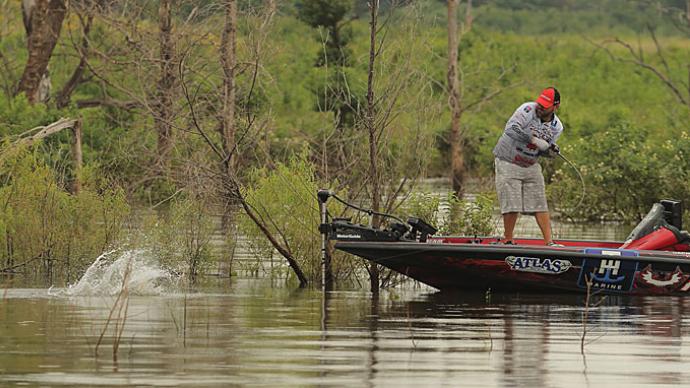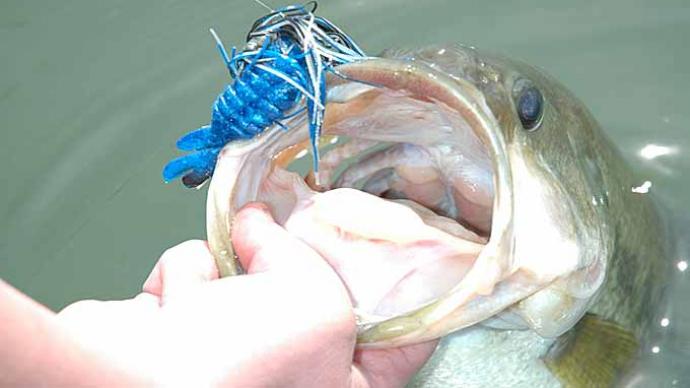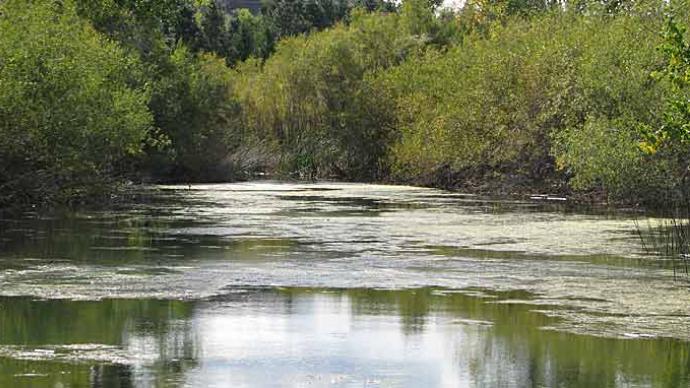
Evolution is a marvelous thing. For example, suppose you look at the various fish found on our planet. In that case, each has developed over time to have specific adaptations aiding in the promulgation and survival of that particular species. Such is the case with our favorite quarry, the largemouth bass.
"Ol' Bucketmouth" has camouflaged coloration, which allows it to hide in and amongst a variety of cover, a large flat tail that gives it tremendous quickness, and a giant maw and gill structure enabling it to suck in prey nearly half its size.
When you get right down to it, bass have become highly adapted to being specialists in guerrilla warfare. They lurk in the shadows, ambush their prey, and retreat to the hiding places they came from. They thrive in areas choked full of brush, aquatic growth, or other debris, either natural or man-made, that facilitates them in their quest for food.
The reason fish congregate in these areas goes beyond the food factor. Just as a plastic pool cover aids in heating your backyard swimming hole, surface debris, whether natural or man-made, absorbs heat and warms the surrounding water. The canopy created by surface debris also shields the fish from direct sunlight. Trees, brush, and other vegetation types also give off absorbed heat and provide oxygen to the water. All this adds up to surroundings which are inviting to bass.
Although our Western reservoirs, with their fluctuating water levels, do not always offer opportunities to fish heavy cover, when they arise, you need to know how to take advantage of them. Whether it's a surface accumulation of matted tulles or just a mass of man-made garbage floating at the back of a cove, the probability that this clutter is holding fish is high.
So how do you get to these hideouts where the bass instinctively lurk? Getting at bass where they live can take some gear, techniques, and know-how, some of which is common knowledge and some of which is rather far out.
Flippin'
Flippin' is a technique whose roots come from the old Southern technique of cane pole dipping with long bamboo shafts. This method gained popularity on the West Coast in the mid-to late-70s due to several tournament wins by Dee Thomas. Flippin's deadly effectiveness of flippin' brought it into the mainstream in the same manner that dropshotting now finds itself at the forefront of the tournament scene.
The advantages of flippin' lie in allowing the angler to precisely place lures into pockets or openings in weed lines or floating mats. In some cases, flippin' will allow you to present baits right through the top of the cover. A typical flippin' outfit consists of a telescoping rod ranging from 7-1/2 feet to 9 feet in length. Lines used range from 20- to 50-pound-test monofilament. Very few anglers will use a spectra braid for flippin' as they can cut into your hand during the pendulum-like presentation.
Any baitcasting reel may be used. However, those models featuring a thumb bar or flippin' switch are preferred by experienced flippers. Flippin' typically limits the angler to present the bait within 15 feet of the boat.
Flippin' consists of taking a length of line with your weak hand and pulling it back while simultaneously lowering the rod tip. This lifts the lure towards the rod tip.
Once the lure is pulled back, you flip the rod tip upward, which sends the lure outward. Next, you use your weak hand with the rod to direct the line outward to place the lure into a pocket in the cover you are fishing. This pendulum-like motion takes some practice to get accustomed to, but most anglers can learn the fundamentals of the technique within an hour.
Baits used for flippin' are almost always a soft plastic or jig because they can be rigged weedless. The ability of your bait to remain free of snags is paramount to your success - anything less will cost you time and end up in frustration.
Whether it's a plastic worm, lizard, creature bait, or fluke-type bait, any plastic is ideal for flippin'. Bucktail or Living Rubber jigs with or without a trailer are also effective flippin' baits, provided they have weed guards. Of course, certain styles and colors will be more productive depending upon the individual characteristics of the waters you're fishing.
Western Pro Byron Velvick states, "It's important to know what type of bottom you have underneath the trash you're fishing. I will stick my rod tip down to feel the bottom ... if it is hard, I'll use a jig or worm. On the other hand, if it is mucky, I'll use a fluke-type bait, as I know the bass will be hitting something suspended in the water column.
For fishing light or broken cover, you can flip jigs or plastics rigged with a lighter weight head in the 1/8- to 1/4-ounce range. Thicker matted cover with few or no openings will require heavier jigs and worms up to 1 ounce to break through the surface carpet. Peg your worm sinkers. Otherwise, your sinker will break through, but your plastic will remain on top.
"When flippin' or pitchin' into the thick canopies, I like to keep my lure on top and let it slowly fall to the bottom keeping a constant eye on my line," continues Velvick. "I'll fish the lure through the entire water column. Many times, the only time the fish would bite was when the lure was rising off the bottom. They wouldn't hit it on top or on the fall, but when the lure started to come off the bottom real slow, you could feel them grab it and start swimming away."
Your presentation should consist of a slow, controlled fall so you can feel bites on the sink. Once you reach the bottom or desired depth, give the bait a shake or two and lift the lure out to repeat the process in the next likely fish-holding spot. Bites will range from having the rod nearly pulled from your hand to slight pressure or line movement when lifting the rod. Either way, set the hook hard when in doubt. The fish you are hooking is nestled in heavy cover, and you need to immediately get him lifted out of the water and into the boat. Flippin' may not be the most glamorous or sporting technique, but it is highly effective under certain conditions.
The ideal time to flip starts during the warming spring months. "Trash, old wood, plastic bags, and other junk that you will find in the backs of coves and creeks in the early spring will absorb heat quicker than the surrounding, open water," notes Velvick. "This is a great time to start looking in these areas - especially when you have calm, sunny days. I usually don't fish the trash early in the morning. Instead, I will wait until about 9 a.m. when the sun is high in the sky, and the water is warming. This is the optimal time to start fishing these areas."
Pitchin'
No, pitchin' is not a method of fishing developed by major league ball players during the off-season. Instead, it is a technique of casting short distances too far for the flippin' technique. Pitchin' involves an almost underhand cast to lay baits softly into a target area near brush. Pitchin' is also used to lay baits underneath overhanging brush and docks.
Unlike flippin', anglers can pitch using standard bass tackle with lines in more manageable weight ranges. Also, unlike flippin', which is biased heavily towards jigs and plastics, pitchin' can be done with most baits.
Although most West Coast tournaments will not allow anglers to fish marinas, pitching can be highly effective around docks and piers. Spinnerbaits, flukes, Brush Hogs, or tube baits perform exceptionally well when pitched under man-made structures. But, again, controlling your line during the fall is essential, as your bait will get hit 50 percent of the time on the sink - especially with tube baits or flukes.
Another great place to pitch is around log jams or other areas with high concentrations of wood. "If you can find lots of wood with a hard bottom, you have just eliminated a lot of water in your search for fish," says Velvick. "I prefer to fish trash with lots of wood, but sometimes some of the best fish-holding spots are the nastiest places, with bottles, plastic, and lots of man-made junk holding an amazing amount of fish that many anglers will pass up. So I key on trash from the spring through the fall".
Brush Bustin'
Anglers always seem to be coming up with novel methods for getting to fish that no one else can, and some of these are somewhat controversial. One such method is commonly called brush busting. But, unfortunately, brush busting is similar to what the name implies. So instead, Anglers will take their boats or use some other means to get into areas other anglers can't.
I remember in my formative years getting my hands on aluminum rental boats and literally ramming them into weed beds to get to large, open areas within the mat. Then, when we couldn't reach these spots, we'd take the anchor, throw it into the matted weeds, and drag it out with the outboard motor to clear a path into these openings.
If a large weed bed existed with no openings, we'd use the same anchor method described above to clear some weeds out. Once an area was cleared, we'd wait an hour to allow any fish that spooked to return to the area. We'd then hit these spots and usually catch some fish from the area we just cleared. Although this method is somewhat questionable, it managed to put fish in the boat.
Another method that locals have used on the Colorado River chain to reach open water pockets in the back of tulles is to motor one's boat at a high rate of speed through the tulles to reach the open pocket. The caveat is the number of anglers I know that have left their boats high and dry on sandbars using this approach. This has produced a few tournament wins but has also caused dismay with many boat insurers. Knowledge of the water depth, currents, and a solid plan "B" should you high center your boat should all be in place before attempting this trick. BassResource.com does not condone this practice; only very experienced boat operators should consider this approach to fishing the trash.
Next time you're out fishing for bass, don't be afraid to get a bit trashy. It just might improve your chances.
Reprinted with permission from Bass West Magazine




